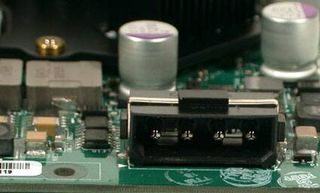Graphics Boosters For OpenGL Workstations
NVIDIA/PNY Quadro FX 3000: Flagship

NVIDIA's new workstation flagship is called Quadro FX 3000 and features a 256 MB video memory. Unknown to many, this model comes in two versions. The differences are limited to equipment, however, as you'll soon discover. Compared to the older FX 2000, the noticeably lower noise levels are a positive improvement.
The heart of the FX 3000 is the NV35GL graphics chip. It is based on the NV35 that has found use in the GeForce FX 5900 Ultra gaming card for some time now. By the way, the GeForce FX 5900 is clocked at 450 MHz in 3D mode; the FX 3000 is 50 MHz slower. Buyers beware: In the area of workstation applications, the link between clock speed and performance is not easy to make.
The Quadro FX 3000 bests its seven opponents in almost all benchmark disciplines.
NVIDIA claims maximum memory bandwidth of 27.2 GB/s. Based on a memory bandwidth of 256 bits, the result is a clock speed of 425 MHz or 850 MHz DDR. Altogether, the NVIDIA has found room for 12 shader pipelines - the FX 2000/1000 has 8 - on its 130 million transistor chip. These calculate up to 100 million triangles/s and 3.2 billion texels/s.
On the resolution front, NVIDIA is out to break records. With the luxury IBM T221 and Viewsonic VP2209b models, they've managed to render an impressive 3840x2400 pixels. For those interested, this resolution bears the unpronounceable standard abbreviation of QUXGA-W.

On the left is the jack for stereo glasses. Analog monitors, using the adapter supplied, or digital flatscreens can be connected through the two DVI-I ports. Even a mixed configuration is possible. The TDMS chip is a cut above. It can already handle dual-link mode - i.e. two channels at once.

Since power needs can no longer be supplied via the AGP bus, the NVIDIA device needs an extra power connector.
Stay on the Cutting Edge
Join the experts who read Tom's Hardware for the inside track on enthusiast PC tech news — and have for over 25 years. We'll send breaking news and in-depth reviews of CPUs, GPUs, AI, maker hardware and more straight to your inbox.
Current page: NVIDIA/PNY Quadro FX 3000: Flagship
Prev Page Hydravision Next Page NVIDIA/PNY Quadro FX 3000G: The Upper-Crust VersionMost Popular


